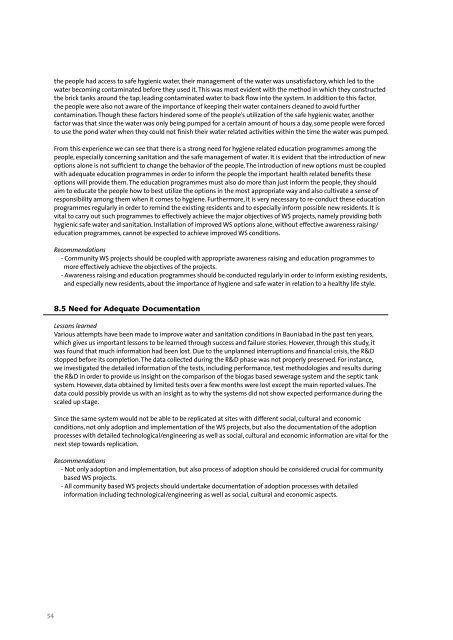Untitled - UNU-IAS - United Nations University
Untitled - UNU-IAS - United Nations University
Untitled - UNU-IAS - United Nations University
Create successful ePaper yourself
Turn your PDF publications into a flip-book with our unique Google optimized e-Paper software.
the people had access to safe hygienic water, their management of the water was unsatisfactory, which led to the<br />
water becoming contaminated before they used it. This was most evident with the method in which they constructed<br />
the brick tanks around the tap, leading contaminated water to back flow into the system. In addition to this factor,<br />
the people were also not aware of the importance of keeping their water containers cleaned to avoid further<br />
contamination. Though these factors hindered some of the people’s utilization of the safe hygienic water, another<br />
factor was that since the water was only being pumped for a certain amount of hours a day, some people were forced<br />
to use the pond water when they could not finish their water related activities within the time the water was pumped.<br />
From this experience we can see that there is a strong need for hygiene related education programmes among the<br />
people, especially concerning sanitation and the safe management of water. It is evident that the introduction of new<br />
options alone is not sufficient to change the behavior of the people. The introduction of new options must be coupled<br />
with adequate education programmes in order to inform the people the important health related benefits these<br />
options will provide them. The education programmes must also do more than just inform the people, they should<br />
aim to educate the people how to best utilize the options in the most appropriate way and also cultivate a sense of<br />
responsibility among them when it comes to hygiene. Furthermore, it is very necessary to re-conduct these education<br />
programmes regularly in order to remind the existing residents and to especially inform possible new residents. It is<br />
vital to carry out such programmes to effectively achieve the major objectives of WS projects, namely providing both<br />
hygienic safe water and sanitation. Installation of improved WS options alone, without effective awareness raising/<br />
education programmes, cannot be expected to achieve improved WS conditions.<br />
Recommendations<br />
- Community WS projects should be coupled with appropriate awareness raising and education programmes to<br />
more effectively achieve the objectives of the projects.<br />
- Awareness raising and education programmes should be conducted regularly in order to inform existing residents,<br />
and especially new residents, about the importance of hygiene and safe water in relation to a healthy life style.<br />
8.5 Need for Adequate Documentation<br />
Lessons learned<br />
Various attempts have been made to improve water and sanitation conditions in Bauniabad in the past ten years,<br />
which gives us important lessons to be learned through success and failure stories. However, through this study, it<br />
was found that much information had been lost. Due to the unplanned interruptions and financial crisis, the R&D<br />
stopped before its completion. The data collected during the R&D phase was not properly preserved. For instance,<br />
we investigated the detailed information of the tests, including performance, test methodologies and results during<br />
the R&D in order to provide us insight on the comparison of the biogas based sewerage system and the septic tank<br />
system. However, data obtained by limited tests over a few months were lost except the main reported values. The<br />
data could possibly provide us with an insight as to why the systems did not show expected performance during the<br />
scaled up stage.<br />
Since the same system would not be able to be replicated at sites with different social, cultural and economic<br />
conditions, not only adoption and implementation of the WS projects, but also the documentation of the adoption<br />
processes with detailed technological/engineering as well as social, cultural and economic information are vital for the<br />
next step towards replication.<br />
Recommendations<br />
- Not only adoption and implementation, but also process of adoption should be considered crucial for community<br />
based WS projects.<br />
- All community based WS projects should undertake documentation of adoption processes with detailed<br />
information including technological/engineering as well as social, cultural and economic aspects.<br />
54
















